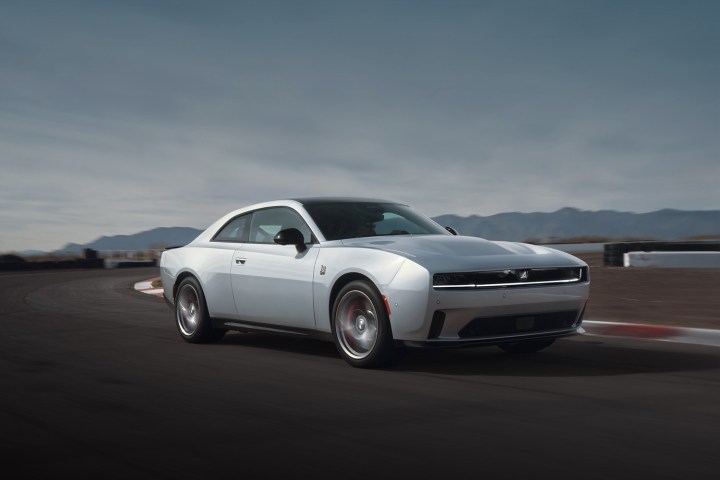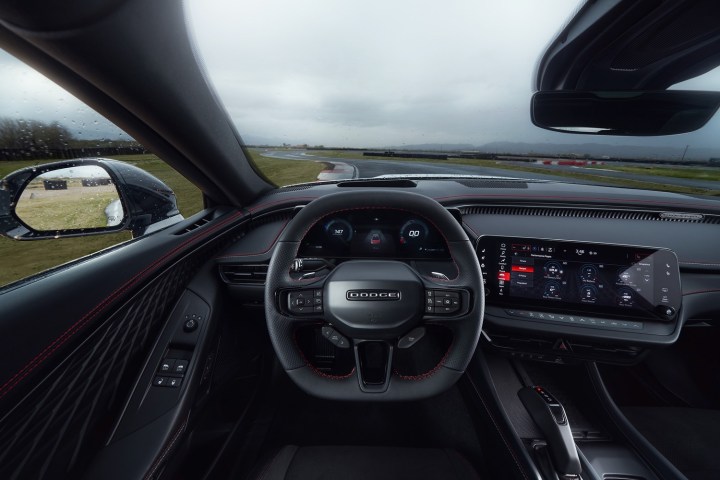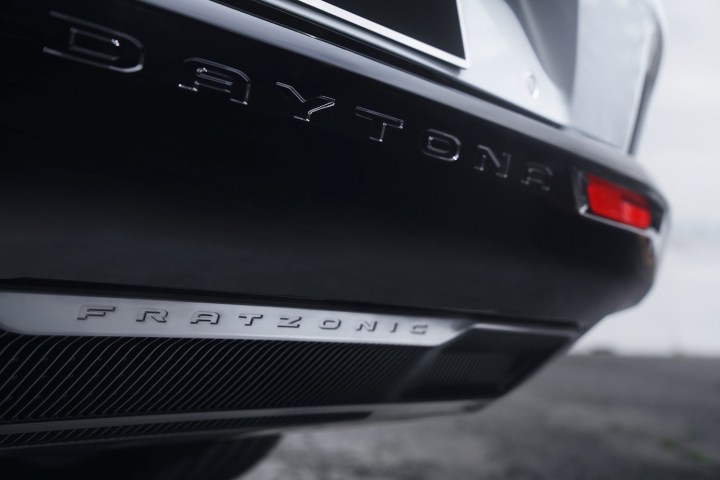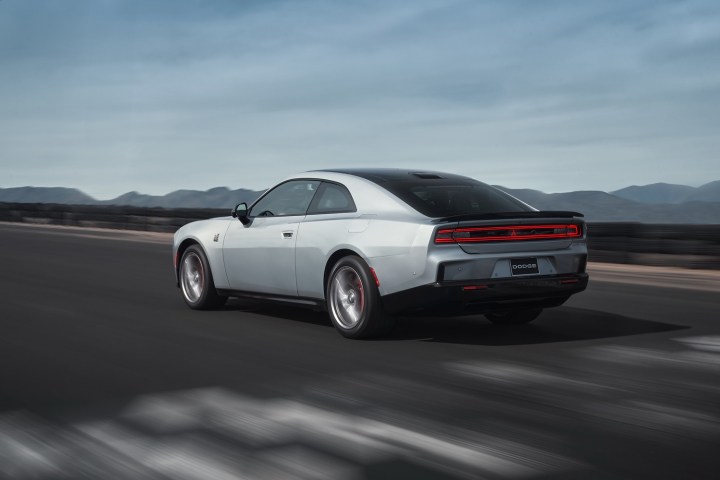
Dodge is finally getting into the EV game, and what better way to start than with a new version of the Charger? While seemingly tailor-made for an electric car, the Charger name also carries the weight of heritage. That led Dodge to take a very different approach with its first EV.
Arriving later this year (with pricing to be determined), the 2024 Dodge Charger Daytona is the replacement for the old gasoline Charger sedan and Dodge Challenger coupe. It tries to appeal to fans of those cars with retro styling, muscle-car sound effects, and an emphasis on performance over efficiency. And if that doesn’t work, Dodge plans to sell a gasoline version as well.
A design straight out of the 1960s

Dodge claims the new Charger wasn’t intended as a carbon copy of the classic 1968 Charger made famous in the movie Bullitt, The Dukes of Hazzard TV show, and the Fast & Furious franchise, but that’s pretty much what we have here. The silhouette is unmistakably that of a classic Charger — and pretty much unchanged from the Charger Daytona SRT concept unveiled in 2022 as the first preview of this new model.
The 1960s Charger’s blunt front end was distinctive but not very aerodynamic. To address that, Dodge gave the Charger EV a patent-pending aerodynamic device called the R-Wing. It’s a slot in the front fascia that allows air to flow up and over the hood more easily. Only electric versions of the Charger have this feature, which is why they get the Daytona badge. The original Charger Daytona was an aerodynamically enhanced model built for better performance on NASCAR racetracks.
Classic Chargers were all two-door coupes, but Dodge has been selling the Charger as a four-door sedan since 2005. With this redesign, those two identities are finally reconciled. The new Charger launches as a coupe (taking over the Challenger’s spot in the lineup) but will also be available as a sedan starting in 2025. Electric and gasoline powertrains will be available in both body styles. And even the coupe has a useful 37.3 cubic feet of cargo space with its rear seats folded.
Stellar performance

The Charger Daytona debuts the STLA Large platform, one of four EV platforms unveiled by Dodge parent Stellantis in 2021. In this case, the platform houses a dual-motor all-wheel drive powertrain tuned for different outputs.
Dodge will launch the Charger Daytona in R/T and Scat Pack configurations, with standard Direct Connection Stage 1 and Stage 2 performance packages, respectively. The Direct Connection packages, which will be extra-cost options following the first batch of production cars, give the R/T 496 horsepower and 404 pound-feet of torque and the Scat Pack 670 hp and 627 lb-ft of torque. However, maximum horsepower is only available in short bursts by pressing the PowerShot button on the steering wheel.
Dodge expects the R/T Stage 1 to do zero to 60 mph in 4.7 seconds and run the quarter mile in 13.1 seconds, while the Scat Pack Stage 2 should be good for zero to 60 mph in 3.3 seconds and an 11.5-second quarter mile. None of these figures are earth-shattering by EV standards, but Dodge has an even more powerful SRT Banshee model on the way. Stellantis has also said the Charger’s STLA Large platform can support zero to 60 mph acceleration in the 2.0-second range. Watch this space.
In 2025, Dodge will also add a gasoline powertrain to the lineup. The 3.0-liter twin-turbocharged inline-six engine, dubbed Hurricane, is already used in the Jeep Wagoneer and Grand Wagoneer SUVs and is making its way into the Ram 1500 pickup truck for 2025 as well. In the Charger, it will make 420 hp or 550 hp.
Electron guzzler

The Charger Daytona is an electric muscle car, Dodge CEO Tim Kuniskis declared in a presentation ahead of the car’s reveal, and muscle-car buyers don’t care about efficiency. So, while the Charger Daytona will offer an estimated 317 miles of range in R/T form and 260 miles in more powerful Scat Pack spec, it needs a massive 100.5-kilowatt-hour battery pack to achieve that.
Models available at launch use a 400-volt electrical architecture (the forthcoming Banshee is 800-volt), so maximum DC fast-charging power is just 183 kilowatts. Still, Dodge expects both the R/T and Scat Pack to charge from 5% to 80% in 32.5 minutes.
Charger EVs will use the Combined Charging Standard (CCS) fast-charging connector for now. Dodge parent Stellantis has said it will adopt the Tesla North American Charging Standard (NACS) connector, but Dodge has no timeline for an NACS rollout. Unlike other automakers, Stellantis also hasn’t discussed arranging access to the Tesla Supercharger network for its customers.
Bigger screens and artificial exhaust noise

When it comes to tech, Dodge had two jobs. It had to replace the old Charger’s aged interface and add some new features to placate muscle car enthusiasts.
On the infotainment side, the Charger Daytona gets a standard 12.3-inch touchscreen. Wireless Apple CarPlay, Android Auto, and Amazon Alexa connectivity are included as well. R/T models also get a 10.25-inch digital instrument cluster, while Scat Pack models get a 16.0-inch cluster. The Charger still runs the familiar Uconnect 5 infotainment system, but the displays have better contrast and new graphics, including reconfigurable instrument-cluster views that can show maps, a rendering of analog gauges, or the bare minimum of information to reduce distraction.
The optional head-up display is also larger and projects images further away for easier viewing. The new Charger is the first Dodge to offer digital key functionality and also debuts the brand’s Drive Experience Recorder for audio, video, and data logging of track exploits. Multiple drive modes are on offer as well, including drift and donut modes that let this all-wheel drive EV perform like a traditional rear-wheel drive muscle car.
Big screens and drive modes are expected features in any new vehicle, but the Charger Daytona’s artificial exhaust system is decidedly unexpected. Dubbed Fratzonic, it uses some of the hardware that makes conventional exhaust systems sound good but with artificial noises generated by speakers. We don’t know exactly what it will sound like (it was still being tuned at press time), but the Fratzonic system will be as loud as the exhaust of Dodge’s current Hellcat V8 engines.
Definitely different

The Charger Daytona is a different kind of EV, and that’s exactly how Dodge wanted it. In a presentation ahead of the car’s reveal, Kuniskis said the electric Charger “fights the system” by appealing to fans of the brand’s gasoline muscle cars rather than EV enthusiasts. But the Charger Daytona is far from the only EV designed to convince skeptical customers not sold on electrification.
EVs like the Ford F-150 Lightning and GMC Hummer EV have already brought electric power to market segments also populated by customers who weren’t exactly running out to buy Teslas. Big pickup trucks and SUVs also happen to be among the bestselling and most profitable vehicles for the American automakers. So yes, the Charger Daytona does fight the system — but it does so by not being just another big truck.
Editors' Recommendations
- Porsche’s most powerful production car is an EV
- Bold style alone can’t muscle Chevy’s new Blazer EV to the head of its class
- Why your EV’s voltage matters, and what it means for your car’s charging speed
- I agonized over EVs but bought a gas car instead. Here’s why I couldn’t be happier
- Ford EV drivers can use 12,000 Tesla Superchargers starting in 2024


